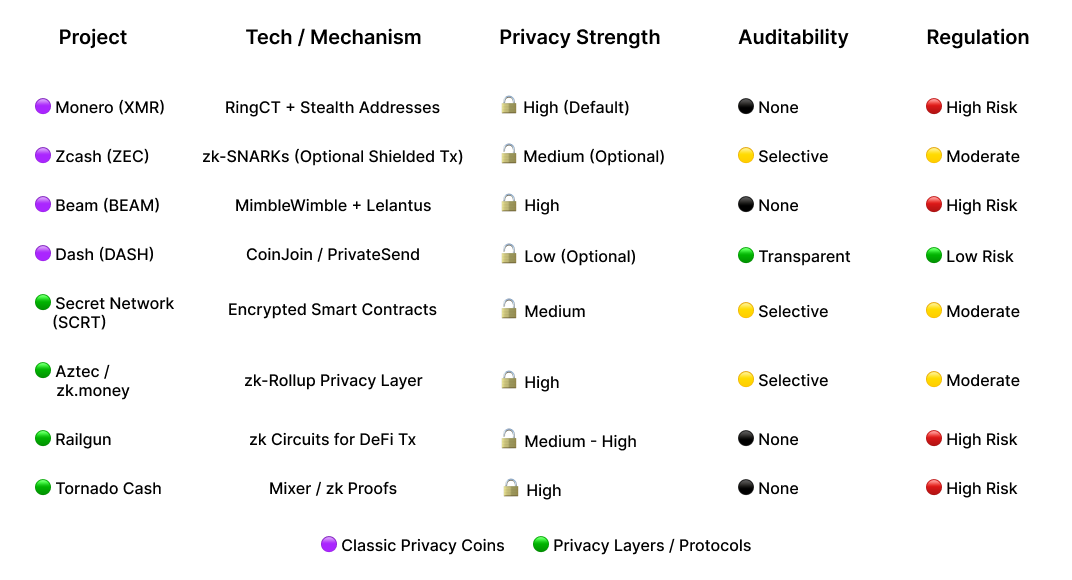In the age of ever-increasing digital surveillance, privacy in finance is becoming a premium. Cryptocurrencies were born with decentralization and transparency at their core – but what happens when transparency becomes a risk? Enter the world of privacy networks and coins: projects built to let individuals transact, exchange and compute in ways that shield sensitive information such as identities or net worth.
Disclaimer: The information provided in this article is for educational and informational purposes only and should not be considered financial, investment, or trading advice. Always do your own research and consult with a qualified financial advisor before making any investment decisions. Cryptocurrency markets are highly volatile and carry significant risk.
A Short History
From the early days of crypto, the tension has been clear: while public blockchains like Bitcoin (BTC) offer openness and verifiable trust, that same transparency leaves participants traceable. Every wallet address, transaction, and token transfer is recorded permanently on a public ledger, visible to anyone with a block explorer. Although addresses appear as random strings, once one is linked to a real identity — through an exchange, NFT purchase, or even a public donation — the entire transaction history becomes searchable and exposed. This level of visibility poses challenges for everyday users, businesses, and institutions that handle sensitive financial data. For mainstream financial and data applications, such full transparency can undermine confidentiality, reveal strategies, and discourage adoption.
Privacy networks emerged to address this tension, preserving blockchain’s security and decentralization while restoring transactional privacy and user control. Projects such as Monero (XMR), launched in 2014, introduced built-in stealth addresses, ring signatures, and confidential transactions so that senders, receivers, and amounts were hidden from view — making every transaction unlinkable and untraceable by default. Meanwhile, Zcash (ZEC) arrived in 2016 with a different approach: optional shielded transactions powered by zero-knowledge proofs (zk-SNARKs), allowing users to prove a transaction’s validity without revealing any details about it. These innovations represented the first major wave of cryptographic privacy on public blockchains — a blend of mathematical precision and philosophical commitment to financial confidentiality.
The Current Landscape
Today, privacy coins are seeing a resurgence. On-chain data shows rising volumes, institutional interest, and a return of user demand for confidentiality in transactions. At the same time, regulatory headwinds are stronger than ever. Many exchanges have delisted or restricted coins that enable anonymity, while compliance regimes (such as the Travel Rule or Europe’s MiCA) push transparency and auditability. Within this environment, projects that combine strong privacy and flexible compliance are gaining attention.
Among the veterans, Monero remains a go-to for users who want strong default privacy. Every transaction is private by design, which enhances fungibility and resists traceability. Zcash offers a different value proposition: the ability to toggle between transparent and shielded modes, and advanced cryptographic upgrades (such as Halo2) to reduce trust assumptions. Other legacy players like Dash, Firo, Beam and Grin have contributed important ideas (mixing, burn-and-redeem, MimbleWimble) though their popularity is more niche.

How Blockchain Privacy Solutions Differ
Privacy in blockchain isn’t a one-size-fits-all concept — different networks take very different paths toward protecting user data. These approaches vary in how they implement cryptography, how much control they give users, and how they balance privacy with transparency and regulation.
At the foundation, technology design defines a project’s philosophy. Some networks embed privacy directly into their base layer, using methods like ring signatures, stealth addresses, or confidential transactions to obscure sender, receiver, and transaction amounts by default. Others use zero-knowledge proofs (zk-SNARKs or zk-STARKs) to let participants prove that a transaction is valid without revealing any details. Newer architectures go even further, encrypting smart contracts themselves so that the logic of decentralized apps — not just the transaction data — can remain private.
Another distinction lies in how privacy is applied. Certain systems make it default, meaning every transaction is automatically private. Others make it configurable, allowing users to choose when to enable privacy and when to remain transparent. This flexibility has become increasingly important for businesses and developers who need to comply with financial regulations or auditing requirements while still protecting sensitive information.
Then there’s the matter of auditability — the ability to verify the validity of a transaction without exposing its contents. Fully private systems provide near-total anonymity but limited visibility for third parties. More flexible frameworks introduce the idea of selective disclosure, where users can grant specific access to transaction data if required for audits, investigations, or compliance reviews. This model bridges the gap between privacy and accountability, giving users greater control over what gets shared and with whom.
Finally, regulatory perception plays a major role in how privacy networks evolve. Systems that make transactions completely opaque often face higher scrutiny from regulators, while those offering optional transparency or selective auditing are finding more acceptance in mainstream finance. As the conversation between innovation and oversight continues, privacy technologies are increasingly being designed to empower users — not hide them — by offering confidentiality, verifiability, and compliance in the same framework.

Innovations & What’s Next
Rather than just improving older coins, the next wave of privacy is expanding functionality beyond simple transfers. Smart-contract platforms are enabling privacy for DeFi, identity, data markets and more. Projects are building privacy as infrastructure — modular shielded layers, cross-chain privacy hubs, encrypted state contracts, view-key mechanisms for auditability. Usability is improving too: unified addresses, simpler wallets, plug-ins for major chains. Cryptography is getting lighter and more efficient, meaning better privacy with less cost.
Still, accessibility remains one of the biggest gaps. While established coins like Monero or Zcash have achieved notable adoption, privacy features are rarely built directly into mainstream wallets or DeFi interfaces. Most users still rely on public-by-default tools where transaction histories are fully visible. Configurable privacy — the ability to toggle between transparent and private modes — is technically possible but not yet common in everyday crypto products. Bridging that usability divide will be crucial for privacy to move from niche adoption to a standard feature across the broader ecosystem.

Why It Matters & Where It’s Going
Privacy isn’t just a niche concern. In a world where digital payments, central bank digital currencies (CBDCs), pervasive tracking and big-data surveillance are becoming real, the ability to transact privately has democratic, commercial and personal implications. For everyday users, institutions, and developers alike, privacy tools will become part of the plumbing of finance and data. Looking ahead, expect:
- Hybrid privacy models where users pick their level of disclosure or auditability.
- Privacy layers embedded in major chains and L2s rather than separate coins only.
- Wider adoption in real-world use cases: remittances, payrolls, identity systems, business contracts.
- Legal and regulatory frameworks that balance transparency requirements with the need for legitimate privacy, encouraging solutions that align with compliance while protecting user data.
- Technical ongoing work on scalability, anonymity set size, resistance to analysis, cross-chain functionality.
Final Thoughts
The innovation and momentum behind privacy-focused crypto is resonant. But the path forward is complex — usability, regulation, liquidity, trust and cryptography all matter. Projects that deliver strong privacy and integrate with mainstream flows (wallets, exchanges, real-world use) will likely thrive. For anyone interested in the future of money, data and autonomy, privacy coins and networks deserve attention.

Thank you for checking out our article on Exploring the Rise of Privacy-Focused Cryptocurrencies! Don't forget to download Enkrypt for a seamless web3 multichain wallet experience. We would love to hear from you on our social media about any guide suggestions you have for the future. Also, if you enjoy using mobile cryptocurrency wallets, give our MEW Mobile app a try, it's available on both iOS and Android platforms!

